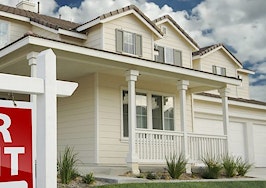- New auto sales were up 13.6 percent in October year-over-year.
- New home sales fell 11.5 percent in September.
- Zero-interest rate policies have helped new car sales but done little for new home sales.
Reposted with permission from Smaulgld.
Earlier this year in “New home sales vs new car sales,” we noted that new car sales were robust while new home sales were stagnant. The most recent data regarding new car and home sales indicate that dynamic remains the same.
New car sales were up 13.6 percent in October year-over-year and are approaching an annual record, while new home sales were down 11.5 percent in September and are at near all time lows.
[Tweet “New car sales were up 13.6% in October year-over-year, but home sales decreased 11.5%.”]
Poor new home sales reflect the general state of the economy far better than the robust new car sales.
Here’s why:
New car sales
New car sales are headed toward a record and strong sales are being achieved by all the major automobile manufacturers (other than Volkswagen which was and is mired in an emissions scandal).
According to AP:
- General Motors’ sales were up nearly 16 percent over last October
- Fiat Chrysler’s rose nearly 15 percent
- Ford and Toyota sales rose 13 percent
- Nissan sales rose 12.5 percent
- Honda sales rose 8.6 percent
What is causing the surge?
Media characterizaton
The mainstream media, attributes the record new car sales to the improving U.S. economy.
Wall Street Journal said it’s “an array of incentives and a favorable economy.”
AP said, “Sales have been greased by cheap financing, low gas prices and an improving economy.”
The reality is massive incentives and long-term financing to sub-prime borrowers at 0 percent are driving new car sales.
[Tweet “Massive incentives and long-term financing to sub-prime borrowers at 0% are driving car sales.”]
While the media is touting record car sales as a sign of an improving economy the reality is far from that rosy scenario. New car sales are not being driven by a strong economy, but rather from:
Increased dealer incentives
New car sales were up 13.6 percent year-over-year in October, but dealer incentives were up even more. According to TrueCar, car companies spent 14.1 percent more than last October on cash-back promotions and other deals.
Without the dealer incentives it’s a safe bet that new car sales would have been flat at best in October.
Long-term financing at 0 percent
During October many car dealerships were offering 0-percent financing for up to 72 months on select vehicles and up to $2,000 cash back. They were essentially paying people to take cars off their lots and recording such transfers as sales.
Car dealers tout affordabiity as a reason for the surge in new car sales. Car payments are more affordable because the terms of car loans are longer.
By stretching car loan payments at 0 percent interest rates over seven years, the monthly payments might be relatively low, but the overall cost of new cars is rising.
Indeed, driven by cheap financing at low or no interest rates, the price of an average new car is at an all time high of $33,560.
No credit, no problem
The dealer incentives have not been reserved for those with the best credit. According to Kroll Bond Rating Agency, more than three-quarters of auto loans are to people with credit scores under 600. A stunning 14 percent of borrowers have no credit score at all.
[Tweet “More than 3/4 of auto loans went to people with credit scores under 600 — 14% had no credit score.”]
Record sales, record debt
According to the Federal Reserve Bank of New York, auto debt was at $1.01 trillion at the end of the second quarter of 2015.
New car sales 1975-2015
The down side of record car sales
With the massive increase in sub-prime lending deliquencies are on the rise.
New home sales
New home sales fell 11.5 percent in September to seasonally adjusted annual rate of just 468,000. New home sales during the past six years are at levels last seen in 1960s and 1970s when the population was 30 percent to 40 percent lower (see chart below).
[Tweet “New home sales fell 11.5 percent in September to seasonally adjusted annual rate of 468,000.”]
With a favorable economy why aren’t more new homes being sold? Are people buying new cars to live in instead?
Perhaps the surge in new car sales and the attendant long-term monthly payments, rising food bills, skyrocketing college tuition and health insurance costs have left the average American with little money left over to save to buy new homes.
Media characterization
The media reports that poor September new home sales figures were a “temporary” setback and the data was “unreliable.”
Reuters said, the new home sales dip is “likely to be temporary,” and a “sturdy housing market is supporting consumer spending and the economy.”
It’s hard to comprehend how Reuters can characterize the lowest home sales in decades as sturdy and supporting consumer spending and the economy.
Consumer spending in September rose a tepid 0.1 percent.
[Tweet “Consumer spending in September rose a tepid 0.1 percent.”]
The New York Times said that the data is unreliable and many more reliable housing indicators have been sending upbeat signals.
USA Today said sales of new homes have soared 17.6 percent during the first nine months of 2015.
The soaring new home sales earlier in 2015 were off some of the lowest new home sales numbers over the past 50 years. The new home sales increases off the bottom were large on a percentage basis but relatively insignificant on a nominal and historic basis (see chart below). Those surging sales have since abated.
The law of small numbers
The reality is new home sales are atrocious, the low sales are not temporary and the housing market is not sturdy.
The housing recovery has been in price alone. New and existing home sales have been sub par mostly due to rising home prices while wages stagnate.
New home sales 1963-2015
The decline in the homeownership rate belies the propaganda that the economy and housing market are recovering. The homeownership rate has fallen from an all-time high of 69.2 percent in the second quarter of 2004, to 67.3 percent at the start of the “recovery” in Q3 2009 to 63.7 percent as of July 2015.
Homeownership rate
Economic recovery cheerleaders claim the housing market is driving the recovery. It’s not. There is no recovery, but they are making a lot of cars and financing them to borrowers with poor credit.
[Tweet “There is no recovery — they’re making a lot of cars and financing them to buyers with poor credit.”]
Louis Cammarosano is the author of Smaulgld, a blog that provides finance, economics and real estate market analysis, and marketing strategies and tips for real estate professionals.







